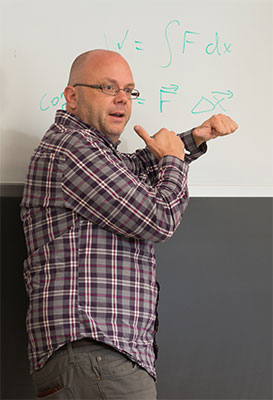'Flipped' classroom improves student learning in physics
News
Some JMU physics students have not had to do homework the past two years . . . at least not the kind of homework that was typically assigned.
Students taking certain physics classes have been doing the work traditionally assigned as homework in class. And rather than listening to lectures during class, they watch pre-recorded lectures outside of class.
"We’re flipping what happens where," said Dr. Scott Paulson, one of four physics faculty members who began using the "flipped" classroom method for the 2013-14 school year. "The content is delivered as homework and when they come to class they work on these problems that ask them to understand and utilize that content toward analysis."
In addition to Paulson, Dr. Adriana Banu, Dr. Brian Utter and Dr. Bill Ingham have been using the flipped classroom method to teach physics 240 and physics 250. They started using that method based on encouraging results from Dr. Chris Hughes, a professor of physics and astronomy who started using the flipped classroom method in fall 2012.
The encouraging results come from a test that is given at the beginning of the semester and then again at the end of the semester to gauge what students learn. For years, when the classes were taught with a traditional lecture during class time, the post-test scores indicated students' knowledge of the subject increased about 25 percent. So if students knew 50 percent of the material at the start of the semester, they knew about 63 percent by the end of it "and people were like, 'Wow, they're not learning 75 percent of what we want them to,'" Paulson said.
"This was seen over and over in a lot of different places and it didn't really matter whether you had an award-winning, crowd-favorite professor that everyone knows is a great professor or an OK one," Paulson said. "You would get gains of 20 percent, 25 percent."
Since going to the flipped classroom method, the gains have been about 35 percent, "almost one and a half times better than what we were seeing before," Paulson said.
One reason the flipped approach works, Paulson said, is because the video lectures are more effective at delivering the course content than the textbook, which is still used as a resource. The textbook provides a sequence for the videos and serves as a supplement to the videos, which Hughes created by combining PowerPoint slides and audio-recorded lectures. In class, students work in small groups on problems, some of them from the textbook, and the teacher provides assistance.
Student reaction to the flipped approach has been lukewarm. "They don't love it," Paulson said. "Some like it better, some think it's awful. I think it's unfamiliar and you always compare to a default. So they can say it's bad because it's worse than lecture, which they know about, but if we had been doing this forever and you changed to lecture, you might see some of this same kind of thing."
Sarah Groth, a biology major who took a flipped Physics 150 class said, "It's a double edged sword. It gives me everything I need out of class so it also gives me the ability to slack off. But I am still learning the stuff because I have to test myself with the homework."
Students are not the only ones who have had to adjust. Paulson said he prefers to lecture, but when the results improve by trying something different, it's worth giving it a chance.
"I don't know if we picked the best approach, I don't know that there is a best one," he said. "I think that a lot of it might have to do with teaching style and what we're comfortable with. Maybe it depends on your student population, but we picked something that we thought seemed promising and we saw results that we're happy enough with that we're going to kind of keep doing this."
Paulson also said professors are willing to try changes to improve the courses' appeal to students. "This is the first time we've done it. Maybe we'll be able to figure out how to do it better. I think many of us are interested in trying some experiments that will allow us to see."
Related content: The flipped classroom method has been around for about 10 years, in high schools and colleges across the country. A recent blog post in The Chronicle of Higher Education discusses the definition of "flipped learning."
And this post addresses skepticism about flipped learning
By Melissa Mowery ('14) and Eric Gorton ('86, '09M)

